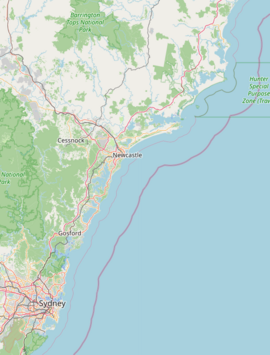Caves Beach, New South Wales facts for kids
Quick facts for kids Caves BeachGreater Newcastle, New South Wales |
|||||||||||||||
|---|---|---|---|---|---|---|---|---|---|---|---|---|---|---|---|
 |
|||||||||||||||
| Population | 4,016 (2021 census) | ||||||||||||||
| • Density | 93.4/km2 (242/sq mi) | ||||||||||||||
| Established | 1829 | ||||||||||||||
| Postcode(s) | 2281 | ||||||||||||||
| Area | 43 km2 (16.6 sq mi) | ||||||||||||||
| Location | 2 km (1 mi) SE of Swansea | ||||||||||||||
| LGA(s) | City of Lake Macquarie | ||||||||||||||
| Parish | Wallarah | ||||||||||||||
| State electorate(s) | Swansea | ||||||||||||||
| Federal Division(s) | Shortland | ||||||||||||||
|
|||||||||||||||
Caves Beach is a cool place found on the Swansea peninsula in New South Wales, Australia. It sits right between Lake Macquarie and the huge Pacific Ocean. This area is part of Greater Newcastle and is managed by the City of Lake Macquarie.
The name "Caves Beach" comes from the many caves along its coastline. It's famous for its surfing beach, which local surfers love. People also enjoy spearfishing here, trying to catch fish like the red morwong. Long ago, the Awabakal people were the first caretakers of this land.
You can find many local businesses in Caves Beach. These include a resort, several restaurants, handy convenience stores, and cafes. There's also a butcher shop and a gelato store for tasty treats.
Contents
Exploring Caves Beach Geography
Caves Beach covers about 43 square kilometers (16.6 square miles). The western part of the suburb is mostly homes where people live. As you move east, you'll find more shops, cafes, and restaurants. The far eastern side is where the beautiful beach is located.
To the north of Caves Beach are Swansea Heads and Ham's Beach. Ham's Beach was named after a family who lived on a hill nearby. A rocky part of Ham's Beach is known as Frenchie's Beach by the locals. To the south, you'll find Pinny's Beach.
Caves Beach History
First People: Awabakal Occupation
Long ago, the plains around Caves Beach were covered with grass trees. The Awabakal people, who were the traditional owners of this land, would gather resin from these trees. This resin was important for making spears. They also had campsites at Ham's Beach because it was a great spot for fishing. They could also find special fine-grained stone there to make tools.
Early European Settlement
Caves Beach was first known as The Plains. Over time, its name changed to Plains Beach, and then to Caves Beach. In 1960, it was briefly called Mawson, but the people living there didn't like the new name. So, in 1965, the name Caves Beach was brought back.
Important Events in the 20th Century
The Swansea-Caves Beach Surf Life Saving Club started in 1929. A group of men from Swansea wanted to create a club to help keep swimmers safe between Swansea Heads and Pinny Beach.
Land was first surveyed for grants in 1864. Later, in 1935, the area began to be divided into smaller plots for building. In the 1940s, a person named Mr. Mawson played a big role in developing Caves Beach. He even tried to start a mining project, but it didn't work out. The breakwater at Spoon Rocks is still there today from this old project. It was built to help load coal onto ships.
In 1958, plans were approved for a new hotel on Caves Beach Road called The Mawson. This hotel became very famous and popular in the 1960s and 1970s. Many well-known bands, like Midnight Oil, Cold Chisel, and The Angels, performed there. The local people loved the hotel. Mr. Mawson eventually sold it in 1981. In 2018, a new restaurant named Mawson opened, reminding everyone of the old hotel.
Education also grew in Caves Beach. Swansea High School opened its doors in 1964. Caves Beach Public School followed in 1968, right next to the high school.
Who Lives in Caves Beach?
According to the 2016 census, there were 4,054 people living in Caves Beach.
- About 2.6% of the people were Aboriginal and Torres Strait Islander.
- Most people (86.5%) were born in Australia. The next largest group (3.7%) was born in England.
- Almost everyone (94.5%) spoke only English at home.
- When asked about religion, the most common answers were No Religion (28.4%), Catholic (23.2%), and Anglican (21.5%).


